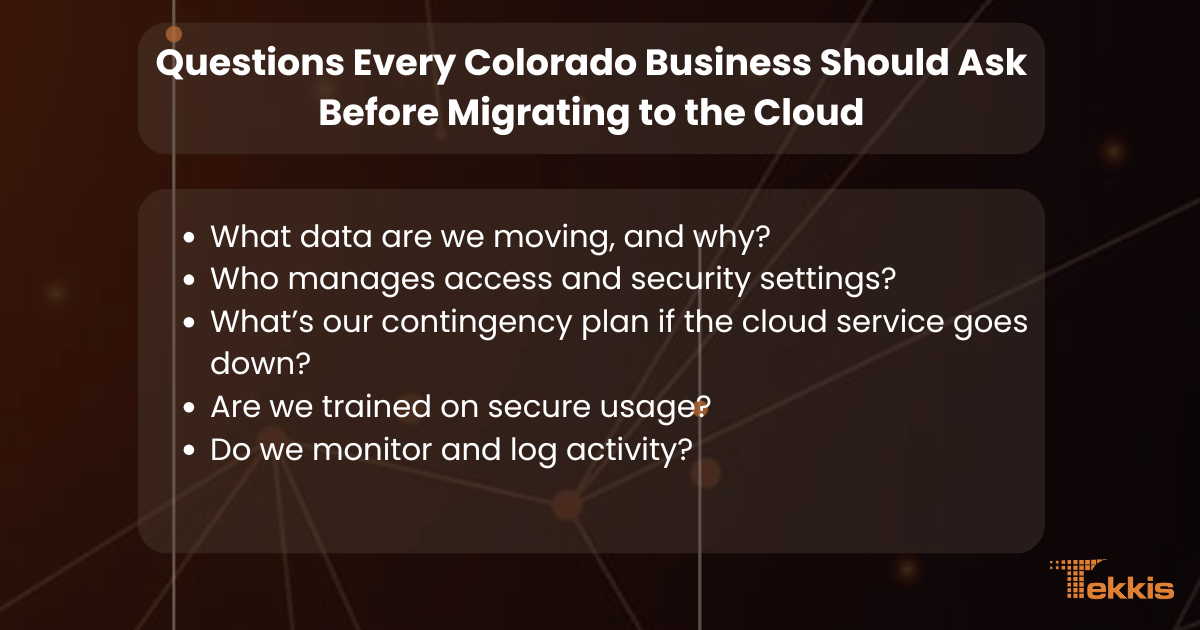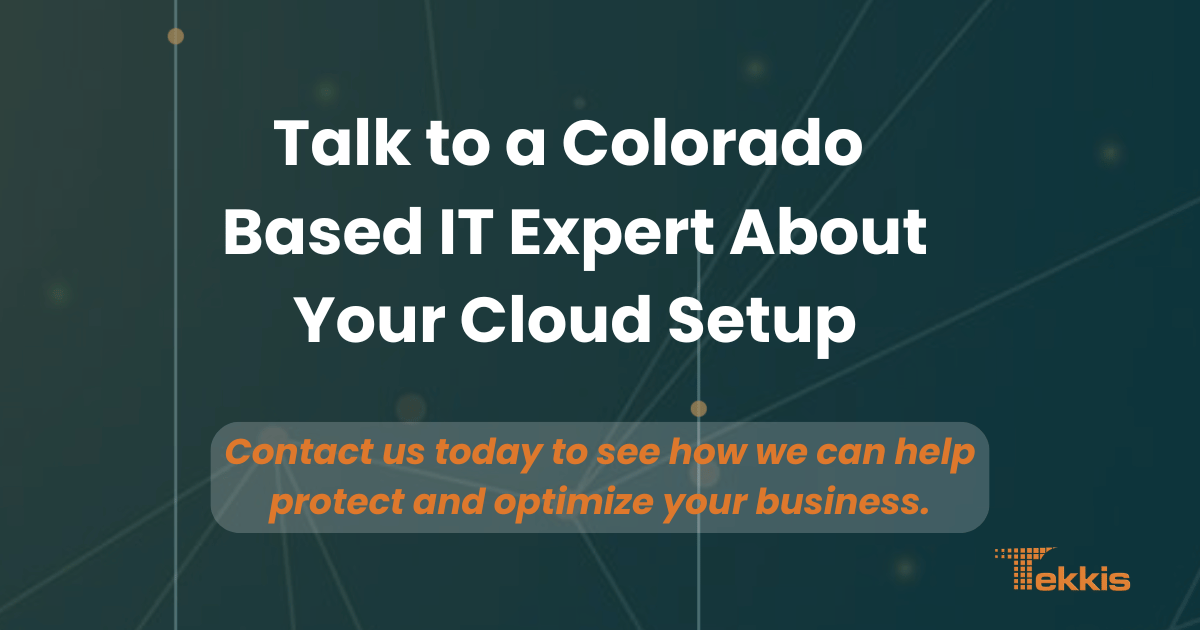It's a Strategy Shift Colorado Businesses Need to Get Right
As cloud computing has become the default mode of IT for many businesses, the original premise “faster, cheaper, better” has been quietly replaced with something far more complex. For dental clinics, law firms, multi-office practices, and growing organizations across Colorado, cloud migration is no longer just a convenience. It's a commitment to an entirely new way of working, storing, and securing data.
At Tekkis, we've worked with dozens of businesses who came to us after running into issues with cloud-based systems, unexpected costs, performance gaps, and above all, security blind spots. That's why we approach cloud computing through the lens of long-term cybersecurity strategy, not just short-term IT efficiency. If you're exploring a move to the cloud or already in it and frustrated, this guide will help you understand the deeper implications of the shift.
For a full overview of how we secure data across cloud and on-prem systems, visit our Cybersecurity Services page.
Also Read:
The Promise of Cloud Computing (and Where It's Falling Short)
The value proposition of cloud computing was originally simple:
- Offload infrastructure costs
- Pay only for what you use
- Scale as you grow
- Access data from anywhere
- Reduce maintenance headaches
And for many small to mid-size businesses, the cloud has delivered on those promises at least partially. Platforms like Microsoft 365, Google Workspace, AWS, and Dropbox have enabled teams to collaborate more easily and shift capital costs to operating budgets.
But problems arise when organizations assume “cloud” automatically means “secure,” or worse, “hands-off.” In reality, cloud platforms are not set-it-and-forget-it solutions. They require constant configuration, monitoring, and integration with your broader cybersecurity strategy.
When the Cloud Gets Complicated
Businesses across Colorado are discovering that cloud systems often introduce new problems rather than solving old ones:
1. Cloud Sprawl and Data Fragmentation
It's common for organizations to adopt multiple cloud tools (email, file storage, CRMs, EHRs, etc.) without a unified access or security policy. This can lead to:
- Sensitive files scattered across platforms
- Inconsistent permissions and role settings
- Disconnected audit trails
2. Misconfigured Access
Most cloud breaches aren't caused by hackers exploiting obscure vulnerabilities—they're caused by human error. A poorly configured Google Drive folder or open AWS bucket can expose client data without anyone noticing until it's too late.
3. Shadow IT
Employees often sign up for cloud-based tools without IT approval (think: Calendly, Canva, Zoom, Notion). While these tools improve productivity, they also introduce unmonitored access points to business data.
4. Vendor Lock-In and Data Portability
Once you're deep into a cloud ecosystem, switching providers or even retrieving your own data can be more difficult than expected. You may be limited by proprietary formats, restrictive terms of service, or downtime during migration.
What's the Alternative? It's Not "Back to On-Prem"
Some industry voices argue that businesses should reconsider on-premises infrastructure. While this may work in highly regulated sectors, it's rarely practical for small or mid-size businesses.
On-prem systems require:
- In-house servers
- Dedicated IT staff
- 24/7 physical security
- Manual disaster recovery plans
For most Colorado-based organizations, maintaining local hardware to the same standard as major cloud providers is unrealistic. Instead, the future lies in cloud architecture that's intentionally designed, secured, and managed as part of a broader strategy not a patchwork of tools and subscriptions.
Rethinking Cloud: It's a Security Project, Not Just an IT Choice
At Tekkis, we don't recommend cloud platforms purely based on price or features; we look at them through a cybersecurity-first lens. That means evaluating:

In other words, we treat cloud computing like what it truly is: a potential security asset or liability depending on how it's deployed.
Questions Every Colorado Business Should Ask Before Migrating to the Cloud

- What data are we moving, and why?
- Is this archival data, active operational data, or sensitive client information?
- Who manages access and security settings?
- Do we have internal protocols for creating, suspending, or revoking user access?
- What's our contingency plan if the cloud service goes down?
- Is business continuity part of our cloud setup?
- Are we trained on secure usage?
- Do employees know how to spot phishing attacks targeting cloud logins?
- Do we monitor and log activity?
- Who reviews access logs, and how often?
The Local Cloud Advantage: Why Colorado-Based Support Matters

While cloud platforms are hosted globally, your IT needs are local. Colorado businesses benefit from working with regional providers who understand the infrastructure, regulations, and risk profiles specific to the area.
Local support offers:
- Faster response times for system issues or outages
- Hands-on configuration during onboarding and upgrades
- Tailored compliance advice based on local and industry-specific laws
- In-person training for staff on secure cloud usage
At Tekkis, we work with companies from Boulder to Fort Collins, helping them design secure cloud environments that scale with their growth without sacrificing control or visibility.
It's Not About Cloud vs. On-Prem It's About Control
The real question isn't “cloud or not?” It's whether your cloud setup is intentional or incidental.
Are you using platforms because they're popular or because they align with your workflow and risk tolerance?
Do you know who has access to your data and how that access is revoked?
Have you planned for worst-case scenarios, or are you hoping they won't happen?
Cloud computing can be a powerful asset but only when it's approached as a long-term investment, not a quick fix.

Final Thoughts: Bring Strategy Back Into Your Cloud Decisions
For Colorado businesses exploring the cloud, success lies in slowing down and asking the right questions. Avoid rushing into platforms that promise convenience but lack real security.
Instead, focus on building cloud systems that:
- Support how your team actually works
- Maintain visibility over critical data
- Meet compliance standards
- Scale without sacrificing control
If you need a second opinion on your cloud environment or want help designing one from scratch our team can help. Learn more about how we integrate cybersecurity into every cloud deployment on our Cybersecurity Services page.



